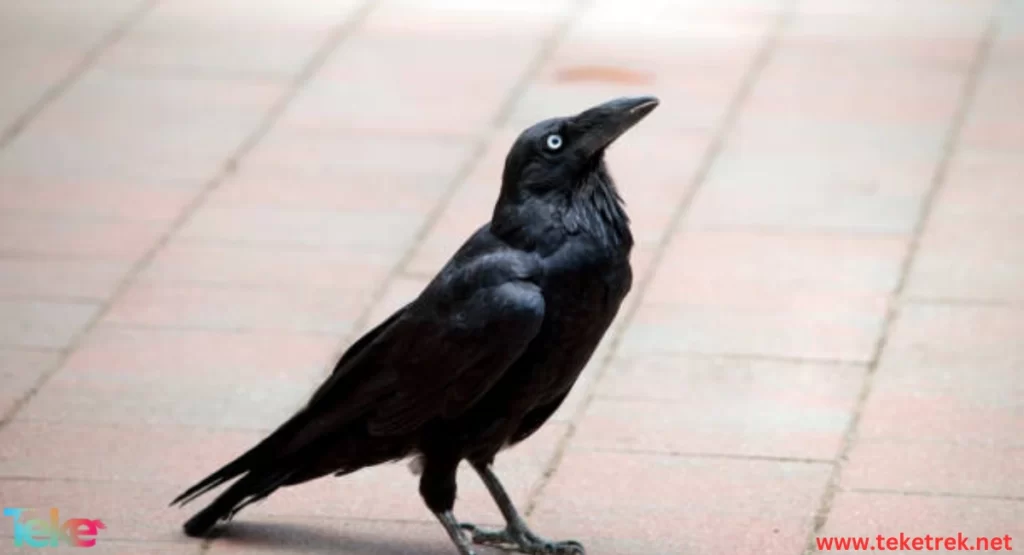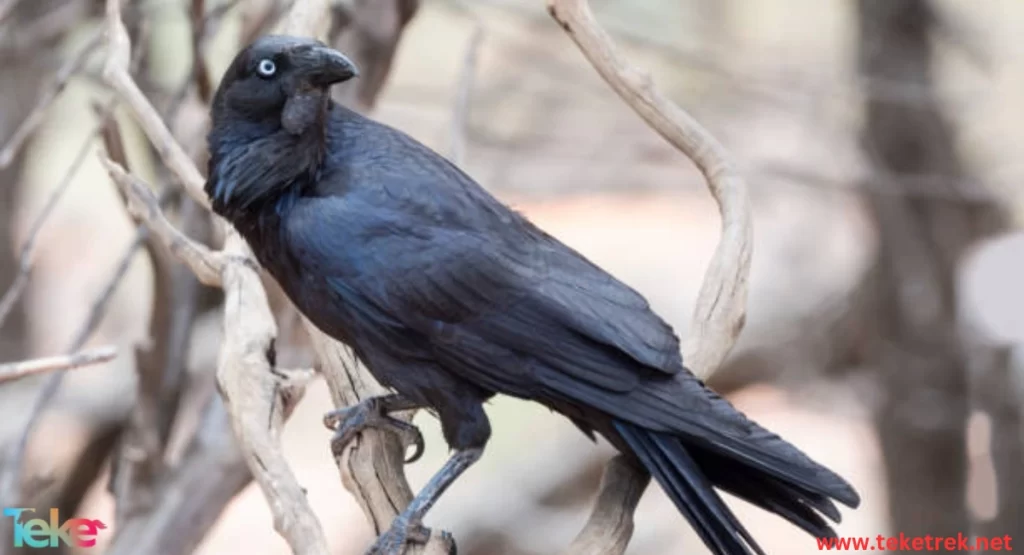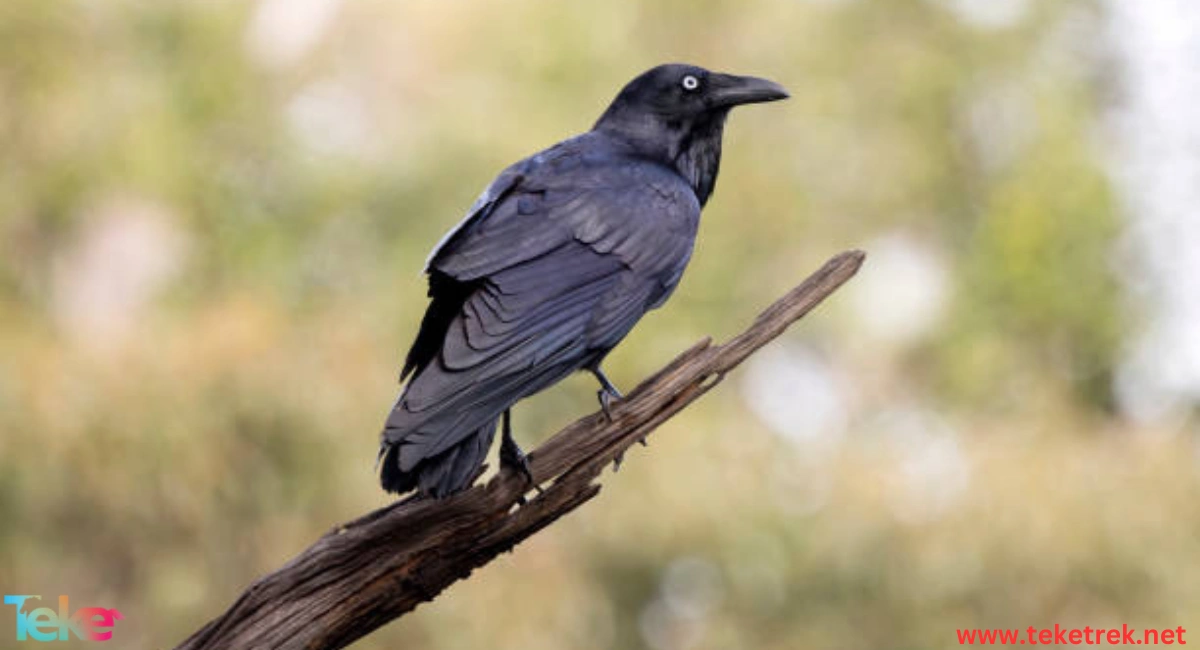The Australian crow is known by the scientific name Corvus coronoides
It is a bird belonging to the crow genus, living in various parts of Australia in the south and northeast.
Let’s learn more about it from teketrek.
The australian raven facts
The Australian raven belongs to the Corvidae family, Birds class, Chordata phylum.
It takes its name from the common raven “C. corone” due to their similarity.
Two distinct subspecies have been identified, differing slightly in vocalizations and being genetically distinct.
The Australian raven can fly up to 64 km in a day and reach speeds of 38 to 96 km per hour.
It has long throat feathers resembling a beard.
its slow, high-pitched call used for communication with other ravens in the area, when giving this call, the bird assumes a horizontal position, raising its head forward and its body parallel to the ground, while usually sitting in a prominent position.
About 3 weeks before laying eggs, the female develops a brood patch of bare skin on her underparts. Which reddens and becomes more spacious. The skin itself wrinkles and is not re-feathered until after the breeding season is over.
While foraging, Australian Raven can pick up golf balls from fairways, perhaps mistaking them for eggs.
Australian Raven can place cut meat in their mouths under their tongue. They sometimes hide the killed prey in a nearby hole to store it for later.

The Australian Raven specification
The length: The Australian raven is 46-53 cm long.
Color: black feathers, beak, and mouth. It has strong gray and black legs and feet, with iridescent blue or green colors on its back and wings.
Adult Australian ravens have white irises, while juveniles have white irises with a blue edge.
The upper part: The upper part of the raven’s head and nasal cheeks are covered with bristles that can reach up to 3 mm in length.
The bill, hook: The Australian raven has a heavy, slightly curved bill with a slight hook, longer than the bird’s head.
Wings, throat: It has long, broad wings and pink bare skin on the throat.
The West African Giraffe: The Tallest Land Animal and the Secrets of Its Amazing Survival
Places where the Australian Raven is found
The Australian Raven lives in open forests and transitional areas, as well as adapts to urban areas. It is a common bird in cities like Sydney, Canberra, and Perth.
Amazing Facts About the Devil Ray: The Biggest Brain and the Secrets of Flying Underwater
What is the diet of the Australian Raven?
Australian ravens are considered omnivorous animals. They feed on the nectar of banksia flowers. Their diet also includes grains, fruits, insects, small animals, carrion, eggs, and garbage from bins.
Australian ravens search for food left behind by humans. They are fond of scavenging through garbage.
They drink a lot of water, consuming about ten times a day if the weather is hot. They may also dip pieces of meat in water before eating them, and often do the same with hard biscuits to keep them moist.

Ways of Communication Among Crows
Crows are highly intelligent birds endowed by God with great mental capacities and an organized way of life. They even played a role in teaching humans at the beginning of creation. They use various methods to communicate, such as sounds and signals. Here are some of the ways they interact:
- Crows use a wide range of vocal calls to communicate, such as warning calls or social calls.
- They employ visual signals, like feather or head movements, to communicate—each movement carries a meaning that humans cannot understand.
- Crows use behavioral communication, such as aggressive posturing or social gestures to attract attention.
The Crow as a Cultural and Historical Symbol
The crow is a cultural and historical symbol in many cultures worldwide. In ancient civilizations like Greece, the crow symbolized gods and cultural beliefs. In Greek mythology, it was considered a messenger of the gods, especially Apollo, the god of the sun. In Norse mythology, crows symbolized wisdom and intelligence and were associated with the god Odin.
In modern Western cultures, the crow is often linked to destruction and death, but also intelligence and wisdom. In Japanese culture, it symbolizes good luck and protection. Literature often uses the crow as a symbol of death or wisdom, as in Edgar Allan Poe’s poem “The Raven.”
Environmental Influences on Crow Behavior
Crows are affected by their environment, and changes in their surroundings can alter their behavior, such as foraging or adapting to new settings. Some environmental effects include:
- Climate change can affect the availability of food and water, leading to behavioral changes.
- Environmental destruction may result in the loss of natural habitats, affecting both social structure and behavior.
- Shifts in the ecosystem can impact the social composition of crows.
Keeping Crows as Pets
Keeping crows as pets can be a unique and exciting experience. They can form strong bonds with their owners and interact extensively. However, they require much care and attention, as well as knowledge of their needs:
- Crows need a varied diet including fruits, vegetables, and proteins.
- They require ample space for flying and movement.
- They need social interaction—either with humans or other birds—as they are social creatures.
Challenges include:
- Crows can be very noisy, which might cause issues in residential areas.
- They may be destructive if not given a suitable environment.
- They require specialized veterinary care, which can be costly.
Why is the Crow Considered Intelligent?
God created the crow with remarkable intelligence and comprehension. It has been taught many skills such as:
- Using tools (like sticks) to retrieve food from tight spaces.
- Logical thinking and smart problem-solving.
- Complex social interactions.
- Utilizing varied vocal calls and visual signals.
- Quick learning and adaptability.
- Excellent memory for places and objects.
- Using rocks to crack eggs or nuts.
- Planning ahead and storing food for later use.
The Relationship Between Crows and Nature
Crows are integral to nature and capable of adapting to various environments—from forests to cities. They play a significant role in ecosystems:
- Feed on insects, worms, and rodents, helping control their populations.
- Contribute to cleaning the environment and reducing disease spread.
- Compete and interact with other animals, impacting the food chain and ecological dynamics.
Crows’ Diet and Food Diversity
Crows are omnivores, meaning they eat a wide variety of foods. Their diet includes:
- Fruits, vegetables, insects, worms, rodents, and carrion.
- Adaptation to the available food in their environment.
- Consumption of crops like wheat and barley.
Why Do Crows Prefer Living in Cities?
Crows are social and highly adaptable, thriving even in urban settings due to:
- Abundant food sources like garbage and waste.
- Relative safety and infrastructure that supports health and survival.
- Safe nesting sites such as trees, rooftops, and buildings.
- Ability to adapt and thrive in city environments.
Protecting Crows from Extinction
Due to their unique lifestyle and behavior, crows face various environmental and human-related threats. Strategies to protect them include:
- Preserving natural habitats like forests and biodiversity.
- Reducing pesticide use and environmental pollution.
- Regulating hunting and educating the public on their importance.
- Raising awareness to prevent overhunting.
Benefits of Crows in Maintaining Environmental Balance
Crows play vital roles in ecosystems. Here are their benefits:
- Pest control by eating insects like locusts and cockroaches.
- Reducing worm populations that harm plants.
- Consuming carrion to clean the environment and reduce disease.
- Minimizing foul odors from decaying matter.
- Contributing to the food chain and maintaining ecological balance.
- Helping in seed dispersal, promoting plant diversity.
- Supporting forest health by eating harmful insects and worms.
The Evolution of Crows Through the Ages
Crows are ancient birds that have evolved into highly intelligent and adaptable creatures:
- They have existed for millions of years.
- Adapted to diverse environments from forests to cities.
- Developed problem-solving and tool-use skills.
- Became socially complex and interactive.
- Show genetic diversity allowing adaptation.
- Fossils indicate their ancient presence.
- They have a long evolutionary history as one of the most successful birds.
Factors Affecting the Life of Crows
Several factors impact the lives of crows, including:
- Climate change affecting food and water.
- Environmental destruction reducing habitats.
- Hunting affecting their numbers.
- Pollution harming their health.
- Competition and interaction with other birds.
- Human interference, both harmful and protective.
- Diseases and injuries affecting their survival.
FAQs about the Australian Raven
1. How does the Australian Raven adapt to its environment?
The Australian Raven has a strong, sharp beak with a small hook at the end, allowing it to tear meat and capture insects and small plants. Its legs are adapted for walking on the ground and it can fly well. These adaptations help the Australian Raven to live in a variety of habitats and consume a diverse range of foods.
2. What threats do Australian Ravens face?
Australian ravens are not endangered species but can be preyed upon by birds of prey like powerful owls or wedge-tailed eagles. Sometimes farmers shoot them when they feed on their crops or animals.
3. Should Australian Ravens be fed by humans?
Humans should not feed ravens as human food is harmful to them. Feeding them can lead to disease as they start to expect humans to feed them. They can become very persistent in following people around for food, trying to access lunch bags and lunch boxes.
4. How do Australian Ravens reproduce? What is their life cycle?
Australian Ravens mate for life and lay their eggs in spring in large nest-like structures made of grass and feathers. Only the female incubates the eggs.
The eggs hatch after about 20 days. After a month, the chicks start growing feathers and remain in the nests for at least six weeks.
The young stay with their parents for three to four months until they become independent enough to live on their own.
5. Are Australian Ravens aggressive?
Australian ravens sometimes forage in mixed-species flocks with any of the other four species of Australian corvids.Sometimes they behave aggressively toward little ravens at a shared food source, driving them away. However, they tend to avoid conflict if the smaller species significantly outnumbers them.
6. Are crows and ravens friendly?
If you were to see a crow and a raven sitting on the same branch, you’d easily distinguish them, as the raven is a much larger bird. However, it’s unlikely you’d ever spot them together, as ravens and crows tend to avoid each other’s company.
7. Are Australian ravens intelligent?
As a member of the corvid family, the Australian Raven is considered one of the most intelligent animals.
In conclusion, it is important to emphasize that this bird, with its distinctive feathers, shape, and appearance, undoubtedly plays a role in maintaining ecological balance. We hope that we have provided you with useful and valuable information and amazing facts about the Australian Raven to help you get to know it better.
References:





